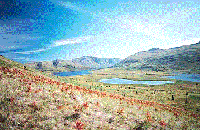|
Airport
Links
. Air
North
. Tourism
. Whitehorse.
Parks
. Yukon
Whitehorse:
Gateway to Canada's Yukon Wilderness Safaris
by
Jerry
W. Bird
 As
capital of the Yukon, Whitehorse is strategically
located at the headwaters of the Yukon River, which
flows all the way to Nome and the Bering Sea. My
partner, the late Gary Chaloner and I spent several
weeks there while producing a Canadian Government
video for the Alaska Highway's 50th Anniversary. It
was a happy homecoming for myself, a native son
born in Dawson City, where the Yukon River meets
the historic Klondike of Gold Rush fame. More
information on Whitehorse Airport and connecting
transportation is now on-line. In addition, here
are some historical excerpts, including one from
the souvenir video. As
capital of the Yukon, Whitehorse is strategically
located at the headwaters of the Yukon River, which
flows all the way to Nome and the Bering Sea. My
partner, the late Gary Chaloner and I spent several
weeks there while producing a Canadian Government
video for the Alaska Highway's 50th Anniversary. It
was a happy homecoming for myself, a native son
born in Dawson City, where the Yukon River meets
the historic Klondike of Gold Rush fame. More
information on Whitehorse Airport and connecting
transportation is now on-line. In addition, here
are some historical excerpts, including one from
the souvenir video.
 The
Alaska Highway The
Alaska Highway
Imagine
yourself a time traveler. The year is 1942; the
month, February. Our whole world is gripped by
total war. For the moment, Axis forces hold the
initiative, and for weeks following the Pearl
Harbor disaster, every ship leaving North America's
Pacific ports is threatened. The president's
directive is clear: Furnish a supply route to the
network of northern airfields - an overland route
to supplement our air and sea lanes; one secure
from attack."
Approval
comes swiftly, and the task begins, with end points
set up by the military at Dawson
Creek, BC.
and Big Delta, Alaska. Overnight, the entire North
mobilizes, as the rugged Trail of '42 rivals the
famous Trail of '98 in worldwide focus. Those of us
living in the Yukon at the time felt suddenly in
the forefront of the action. What some called North
America's greatest construction project since the
Panama Canal began as a marvel of mobility at the
time.
The
Alaska Highway was also a massive sea-bridge,
spanning the coastal fjords of the Inside Passage
to historic Skagway, then over the White
Pass
by
narrow-gauge railway to Whitehorse on the Yukon
River, or up-coast to Valdez, Alaska, near
Anchorage. Inland, a 500-mile connection existed
via rail and dirt road, from Edmonton to the
staging point at Dawson Creek, BC. Mere dots on the
map soon became feverish anthills of activity, as
mountains of supplies and acres of equipment were
stockpiled along the way. The fleet
of paddle wheelers that had plied the Yukon (from
Whitehorse) since the Gold Rush of the 1890s was
pressed into service, since there were no real
roads connecting the territory's main communities.
From the Canadian Government Video "Alaska Highway:
The 1st 50 years," by Jerry W. Bird.
Continued.
The Railway Built of Gold
My real-life experience with railways and
railroad memorabilia goes back to childhood days,
when the White Pass & Yukon Railway of Gold
Rush fame was linked via Skagway, Alaska, to a vast
transportation system of Alaska-bound steamships
and Yukon riverboats. Each trip I made from Dawson
City to Vancouver involved four days upstream on
the Yukon River by paddle wheeler; a day trip by
the White Pass & Yukon narrow gauge train from
Whitehorse to Skagway. I am pleased
to see that a section of the railway line may soon
be restored - to Carcross, a short drive from
Whitehorse. Now they've gone that far, why don't
the powers that be seize the moment and return the
train service the rest of the way? If I hear any
such announcement, it will be on this site in a
wink. With the reinstalled service - a total of 108
km, the WP&YR is now the longest-operating
narrow-gauge railroad in North America.
Continued.
AIRPORT
REFERENCE
Whitehorse International Airport (IATA:
YXY, ICAO: CYXY) is located in Whitehorse,
Yukon, Canada. It is part of the National Airports
System, and is operated by the government of the
Yukon Territory. The airport has one Fixed Base
Operator for fuel, limited aircraft maintenance
facilities. The control tower operates from 7 a.m.
- 9 p.m. local time, and the Whitehorse Flight
Service Station provides Airport Advisory Service
during the remaining hours.
In
addition to scheduled commercial service, numerous
small charter operators and bush pilots use the
airport and it serves as a major base for water
bombers used in forest firefighting operations. The
airport also controls a float plane base on
Schwatka Lake.
Whitehorse
is also a major stopover point for private flyers
who make the trip to Alaska. During the September
11, 2001 attacks, two aircraft approaching the
United States from Asia were diverted to Whitehorse
as part of Operation Yellow Ribbon, they were two
Korean Air 747s, one of which was feared hijacked
but this was not the case &emdash; the plane was
low on fuel. Many of the buildings in the downtown
area below the airport were evacuated. Those who
witnessed the plane's landing saw the Royal
Canadian Mounted Police order the crew out at
gunpoint.
The
airport's parking lot is graced by an old Canadian
Pacific Air Lines Douglas DC-3 on a pedestal that
serves as a wind vane. That particular craft first
served for the United States Army Air Force in
southeast Asia during World War II, before being
sold after the war for commercial airline
service.
Airlines
and destinations
•
Air Canada
•
Air Canada Jazz (Vancouver)
•
Air North (Vancouver, Calgary, Edmonton, Dawson
City, Inuvik, Old Crow, Fairbanks)
•
Condor Airlines (Frankfurt)
[seasonal]
•
First Air (Fort Simpson, Yellowknife)
|

